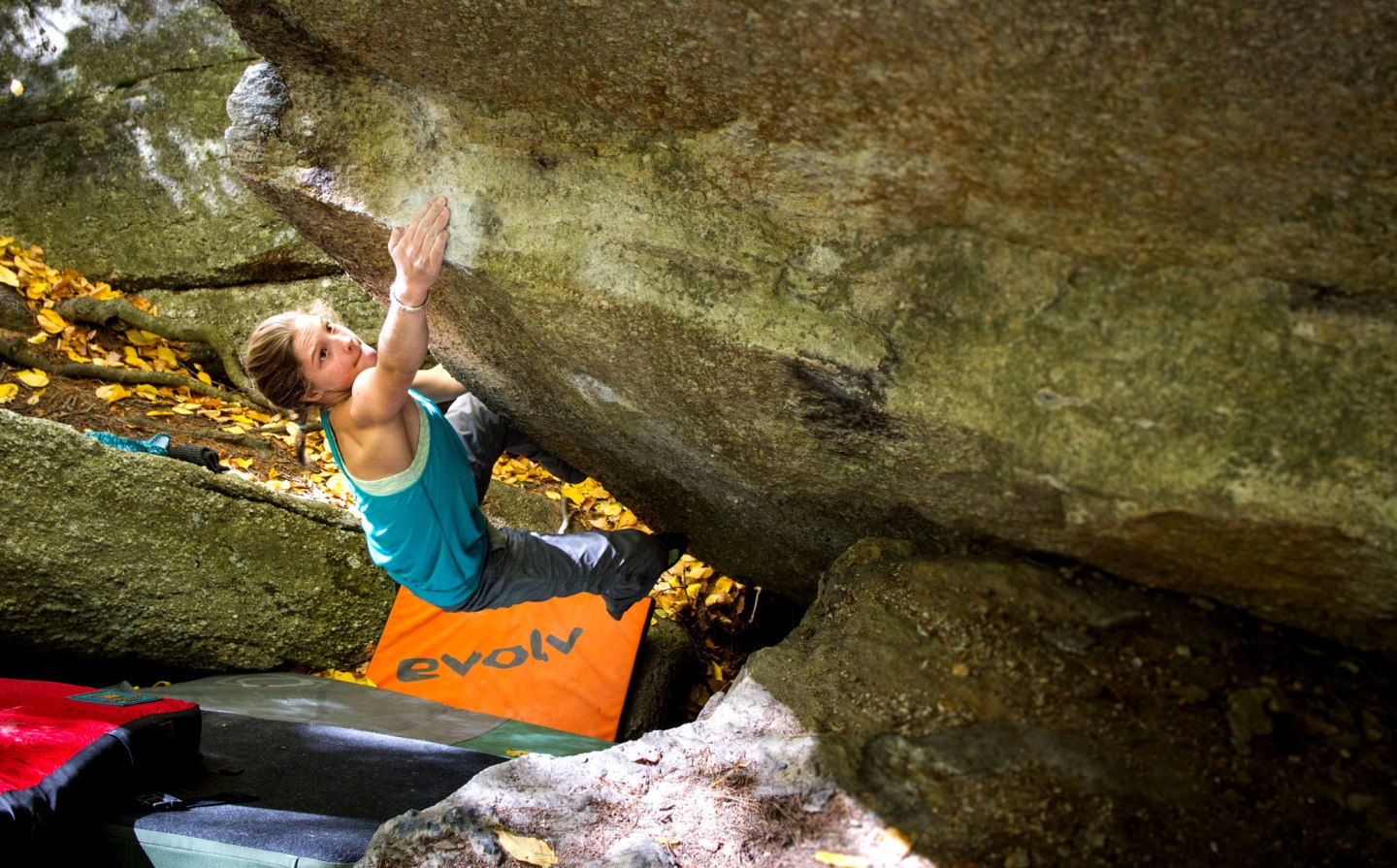Research > Research Inventory > Biomechanics: Contact Strength
Four weeks of finger grip training increases the rate of force development and the maximal force in elite and world-top ranking climbers
Author: G. Levernier and G. Laffaye | Year: 2017
Summary/Results: The researchers measured “Rate of Force Development” (RFD – similar to how fast you can create force) in multiple finger grip positions on a group of French National Bouldering Team members undertaking an RFD training protocol and a national team group not under-taking the protocol. Measurement occurred at two points: the initial change in force (100-200 milliseconds into the contraction) and a later change in force (95% of maximum). The protocol approximates maximal sustained grip training on one hand for 6 seconds to failure, using individualized hold depths between 25 mm and 6 mm for both hands and for two grip positions: the sloper grip and the half-crimp. Training had an impact on the initial change but not on the later change in force, suggesting that it increased the brain-muscle connection but not the underlying structure of the muscle. On a practical note, the researchers suggest that changes in RFD may be transferable across grip positions, suggesting it may not be necessary to develop RFD in the full-crimp grip position to see gains. Beta-Angel note: A new effect found from a protocol some climbers may already be familiar with. Hangboarding for contact strength?! Stay safe my friends.
Reference: J Strength Cond Res. 2017 Sep 19
https://www.ncbi.nlm.nih.gov/pubmed/28945641
Correlation between relative peak-, isometric force and RFD and climbing performance
AUTHORS: V. Vereide , J. Kalland , A.K. Solbraa , V. Andersen , A.H. Saeterbakken | Year: 2016
SUMMARY/RESULTS: Study authors tested climbing performance against multiple different approaches to measuring the force applied through fingers in twenty male sport climbers divided into four ability groups. The authors found that peak finger force as measured by a force cell, rate of force development over a short period of time, and maximum isometric force over a longer period of time were all significantly correlated with climbing performance.
REFERENCE: 3rd Rock Climbing Research Congress, Proceedings 2016
https://docs.wixstatic.com/ugd/441095_76117ef587b34539bc29d428a39b366b.pdf
Internal responsiveness of two methods for assessing maximal strength and peak rate of force development in lead rock climbers
AUTHORS: M. Fanchini, L. Bortolan, B. Pellegrini, R. Modena, F. Schena | Year: 2014
SUMMARY/RESULTS: The authors explored the use of two different measurement tools (a climbing-specific dynamometer and a handgrip) using two different approaches to measuring the effect of fatigue from a climb (MVC or squeezing really hard, and pRFD or squeezing as hard as possible as fast as possible) on 23 amateur climbers. The authors of the study suggest that pRFD is more appropriate to MVC in investigating fatigue in climbing activity, and recommend using pRFD with a climbing specific dynamometer as opposed to a handgrip.
REFERENCE: 2nd International Rock Climbing Research Conference, Sep 2014
https://docs.wixstatic.com/ugd/441095_f52f11ccc489434bb70b78ee10563b95.pdf
Differences in climbing-specific strength between boulder and lead rock climbers
AUTHORS: M Fanchini, F. Violette, FM Impellizzeri, NA Maffiuletti | Year: 2013
SUMMARY/RESULTS: Researchers tested finger strength and “rate of force development” (RFD), potentially an indicator of contact strength, in 10 boulderers and 10 lead climbers (Beta-Angel note: while the trad climbers stood by and laughed, drinking beer in their “The Devil is a hangdog”, “Sport Climbing is Neither”, and “Bouldering is Dumb” t-shirts). While both measurements were greater in boulderers than lead climbers, the researchers suggest RFD may be more appropriate than finger strength for investigating muscle function due to the extent of the difference.
REFERENCE: J Strength Cond Res. 2013 Feb;27(2):310-4
https://www.ncbi.nlm.nih.gov/pubmed/22505133
Muscle fatigue induced by rock climbing lead competition and simulation
AUTHORS: M. Fanchini, FM Impellizzeri, L. Bortolan, F. Schena | Year: 2010
SUMMARY/RESULTS: The authors assessed two different approaches to measuring the effect of fatigue from a climb (MVC or squeezing really hard, and pRFD or squeezing as hard as possible as fast as possible) in both 12 competition climbers and 14 non-competition climbers. The authors found that pRFD declined significantly more than MVC and as a result, they suggest that pRFD (peak rate of force development) is an over-looked parameter for the assessment of muscle fatigue in climbers.
REFERENCE: 15th annual ECSS Congress. 2010, At Antalya/Turkey
https://www.researchgate.net/publication/264157004_Muscle_fatigue_induced_by_rock_climbing_lead_competition_and_simulation
Vertical hand force and forearm EMG during a high-step rock-on climbing move with and without added mass
AUTHORS: RL Jensen, PB Watts, JE Lawrence, DM Moss, JM Wagonsomer | Year: 2005
SUMMARY/RESULTS: Researchers tested the difference between the amount of force applied to a hold (using a force plate) and the activation of the muscle as measured by electromyography which measures muscle electricity. Researchers found a discrepancy between the force on the hold and the exertion by the measured muscle, suggesting that maximal strength may be more important for the initial contact of the rock rather than for sustaining contact with the rock.
REFERENCE: Jensen, RL, Watts, PB. Vertical hand force and forearm EMG during a High-step Rock-on climbing move with and without added mass. In Proceedings of the XXIII International Symposium of Biomechanics in Sports (Qing Wang, editor) 2005; 466-469
http://commons.nmu.edu/cgi/viewcontent.cgi?article=1016&context=facwork_conferencepapers
